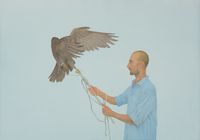

Jhaveri Contemporary is pleased to present a solo exhibition by Ali Kazim at Frieze No.9 Cork Street, featuring new work by the artist, primarily in blue, across four ongoing series.
The colour blue—from the palest turquoise to the darkest indigo—unites the works across this exhibition. Blue is the colour of the sky and water, of vastness and longing. It is associated with melancholy too, and is a metaphor for the spiritual. The significance of blue in literature, art and craft across Persian and Indian traditions cannot be overemphasised: from manuscript paintings and architectural decoration to glass and cloisonné, textiles, and carpets. Blue also has talismanic and shamanistic associations, believed to be capable of repelling the 'evil eye', connecting people across the Middle East, Turkey, Egypt, and beyond.
For his virtuosic, timeless portraits, Ali Kazim draws upon the varied traditions and innovations of Mughal, Rajput, and Company School paintings. His protagonists are almost always presented against plain, context-free backgrounds. He uses this simple arrangement—a subject in front of a flat plane of colour—in the Children of Faith series, where minutely observed details like a wisp of hair or a twist of the neck become intensely expressive. Floating against unmodulated backgrounds, and saturated with thin layers of watercolour wash, Kazim's portraits are a tour de force of emotion.
Buddhist sculpture from Gandhara further informs works in this exhibition. In a series of stunning self-portraits, Kazim fashions himself as a demon from Mara's Army, referencing a 2nd century AD Gandharan relief from the Peshawar District, now in the Lahore Museum (fig 1). Mara was an evil spirit who was afraid that his power would be compromised if Buddha showed all how to attain Enlightenment. The relief depicts Mara's army trying to distract Buddha before he achieves Enlightenment. The sculptor(s) of the relief depict the forces of delusion as a horde of human-animal hybrids. In most ancient representations of this scene, the snarling demons are almost comical. In Kazim's version they are flesh and blood; the only trace of their demonic past flash in their beady eyes, curling tusks and grimacing expressions.
Birds, more particularly the relationship between humans and birds, are a relatively recent preoccupation for Kazim. At first inspired by the spiritual dimensions of Sufi poet Farid ud-Din Attar's poem, The Conference of the Birds, Kazim's interests now concern the environment. In the Bird Hunter series, he considers the illegal trade in wildlife. Migratory birds that travel from Siberia to South Asia are often hunted by locals, who trap them by wearing avian head dresses. These birds no longer speak for mankind as they do in Attar's allegorical poem, which highlights the human struggle to attain Enlightenment.
Press release courtesy Jhaveri Contemporary.
9 Cork St,
London W1S 3LL,
United Kingdom
Tuesday – Saturday: 10am–6pm